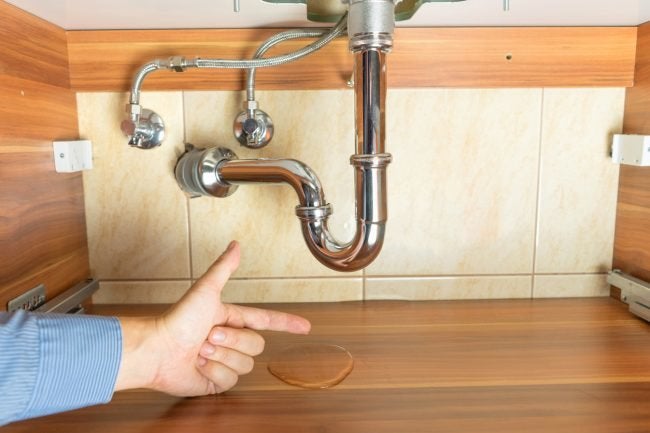Just how to Check If Your Home Has a Covert Leak
Just how to Check If Your Home Has a Covert Leak
Blog Article
We've stumbled on this post involving Detecting hidden plumbing leaks listed below on the internet and concluded it made sense to share it with you on my blog.

Early discovery of leaking water lines can minimize a possible catastrophe. Besides saving you cash, it will certainly decrease the worry and aggravation. The moment you locate a leakage, calling your plumber for fixings is the very best service. Nevertheless, some little water leaks may not be visible. If you can not discover it with your nude eyes, right here are some hacks that aid.
1. Analyze the Water Meter
Examining it is a surefire method that helps you uncover leakages. If it moves, that indicates a fast-moving leak. This suggests you might have a slow leak that could also be underground.
2. Examine Water Intake
If you find sudden changes, in spite of your usage being the very same, it suggests that you have leaks in your plumbing system. An unexpected spike in your expense shows a fast-moving leak.
A stable rise every month, also with the same routines, shows you have a sluggish leak that's additionally gradually escalating. Call a plumber to thoroughly check your residential property, specifically if you feel a warm location on your flooring with piping underneath.
3. Do a Food Coloring Examination
When it comes to water intake, 30% originates from bathrooms. Test to see if they are running properly. Decrease flecks of food color in the storage tank and wait 10 minutes. There's a leak between the storage tank as well as bowl if the shade in some way infiltrates your dish throughout that time without flushing.
4. Asses Exterior Lines
Do not neglect to inspect your outside water lines as well. Needs to water seep out of the connection, you have a loosened rubber gasket. One little leak can lose lots of water as well as increase your water costs.
5. Evaluate and also Analyze the Situation
Homeowners should make it a practice to inspect under the sink counters as well as also inside closets for any type of bad odor or mold and mildew growth. These two red flags show a leakage so prompt focus is needed. Doing routine examinations, even bi-annually, can save you from a significant problem.
Much more importantly, if you understand your home is currently old, maintain a watchful eye on your heating units, hoses, pipelines etc. Check for discolorations as well as compromising as many devices as well as pipes have a life expectancy. They will also naturally wear away as a result of tear as well as wear. If you suspect dripping water lines in your plumbing system, don't await it to escalate. Call an expert plumber as soon as possible so you do not end up with a terrible mess in your home.
Early detection of leaking water lines can reduce a prospective calamity. Some tiny water leakages might not be visible. Inspecting it is a guaranteed way that assists you uncover leakages. One little leak can squander loads of water and also surge your water bill.
If you presume leaking water lines in your plumbing system, do not wait for it to intensify.
How to Know If Your Home Has a Hidden Leak
Water Meter Reveals Inexplicable Water Usage
If you’d like to test whether or not there’s a leak somewhere in your home, you can do this using your water meter. Here is how to conduct the test:
Don’t use any water in your home for at least 30 minutes; this also means not turning on faucets or water-using appliances.
Go outside, and check your water meter for activity.
If your water meter shows that there was activity, even though no one was using any water, this proves that there is a leak in your home.Visible Mold or Mildew Growth
Leaks behind walls create moist, dark environments that allow mold and mildew to grow and thrive. Eventually, you might see mold growth forming on the wall closest to a hidden leak.
If mold is growing in an area that receives a high amount of moisture, such as a bathroom, it may simply be an indication that better ventilation is needed. However, if you see mold growth on a wall or the ceiling in an area where you would not expect, you probably have a hidden leak.
Musty, Mildew Odor
Sometimes you might not be able to see the mold or mildew that is growing as a result of a leak. However, the smell can give the problem away just as easily. If you catch a whiff of something musty, there’s a good chance that old water is collecting somewhere in your home that you can’t see.
Stained/Warped Walls, Ceilings, or Floors
When your home soaks up water, a variety of red flags can become visible, including ceiling stains, bubbling drywall, warped walls, and sagging floors. While these issues can be caused by excess humidity, they can also be signs that a pipe or plumbing connection has started leaking behind your walls.
Inexplicably High Water Bill
After a while, you get a general sense for what your water bill should be. If you own a pool or sprinkler system, your bill will tend to be higher during summer. However, if you receive a water bill that seems especially high, and you can’t figure out what caused it, then you may have a hidden leak somewhere that’s increasing your bill.
https://www.plumbingjoint.com/blog/2019/july/how-to-know-if-your-home-has-a-hidden-leak/

I recently found that piece of writing about Hacks to detect leaks while doing a lookup on the internet. Do you know about somebody who is very much interested in the niche? Please feel free to promote it. I appreciate reading our article about Finding hidden leaks.
Report this page